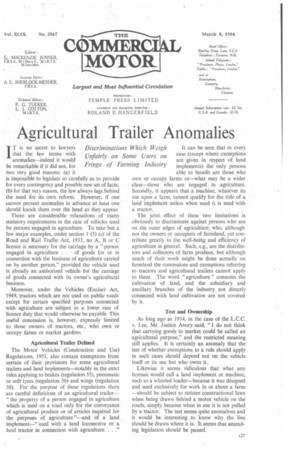Agricultural Trailer Anomalies
Page 29

If you've noticed an error in this article please click here to report it so we can fix it.
T is no secret to • lawyers that the law teems with anomalies indeed it would be remarkable if it did not, for two very good reasons: (a) it is impossible to legislate so carefully as to provide for every contingency and possible new set of facts; (b) for that very reason, the law always lags behind the need for its own reform. However, if one cannot prevent anomalies in advance at least one should knock them over the head as they appear.
There are considerable relaxations of many. statutory requirements in the case of vehicles used• by persons engaged in agriculture. To take but a• few major examples, under section 1 (5) (c) of the Road and Rail Traffic Act, 1933, no A, B or C licence is necessary for the carriage by a " person engaged in agriculture . . of goods for or in connection with the business of agriculture carried on by another person," provided the vehicle used is already an authorized vehicle for the carriage of goods connected with its owner's agricultural business.
Moreover, under the Vehicles (Excise) Act, 1949, tractors which are not used on public roads except for certain specified purposes connected with agriculture are subject to a lower rate of licence duty that would otherwise be payable. This useful concession is, however, expressly limited to those owners of tractors, etc.., who own or occupy farms or market gardens.
Agricultural Trailer Defined The Motor Vehicles (Construction and Use) Regulations, 1951, also contain exemptions from certain of their provisions for some agricultural trailers and land implements—notably in the strict rules applying to brakes (regulation 55), pneumatic or soft tyres (regulation 56) and wings (regulation 58). For the purpose of these regulations there are careful definitions of an agricultural trailer" the property of a person engaged in agriculture which is used on a road only for the conveyance of agricultural produce or of articles required for the purposes of agriculture "—and of a land implement—" used with a land locomotive or a land tractor in connection with agriculture. . . ." It can be seen that in every case (except where exemptions are given in respect of land implements) the only persons able to benefit are those who own or occupy. farms or—what may be a wider class—those who are engaged in agrieulture. Secondly, it appears that a Machine, .whatever its use upon a farm, cannot qualify for the title of a land implement. unless when usedit is used with a tractor.
The joint effect of these two limitation is obviously to discriminate against persons Who are on the outer edges of agriculture; who, although not the owners or occupiers of farmland, yet contribute greatly to the well-beirig and efficieney of agriculture in general. Such,,e.g., are-the distributors and collectors of farm produce, but although much of their work might be done actually on farmland the concessions and exemptions referring to tractors and agricultural trailers cannot apply to them. The word " agriculture " connotes the cultivation of land, , and the subsidiary and ancillary branches of the industry not directly connected with land cultivation are not covered by it.
Test and Ownership As long ago as 1914, in the case of the L.C.C. v, Lee, Mr. Justice Avory said, "I do not think that carrying goods to market could be called an agricultural purpose." and the restricted meaning still applies. It is certainly an anomaly that the test of whether exemptions to a rule should apply in such cases should depend not on the vehicle itself or its use but who owns it.
Likewise it seems ridiculous that what any layman would call a land implement or machine, such as a wheeled loader—because it was designed and used exclusively for work in or about a farm —should be subject to stricter constructional laws when being drawn behind a motor vehicle on the roads, simply because when in use it is not pulled by a tractor. The test seems quite anomalous and it would be interesting to know why the line should be drawn where it is. It seems that amending legislation should be passed.




































































































